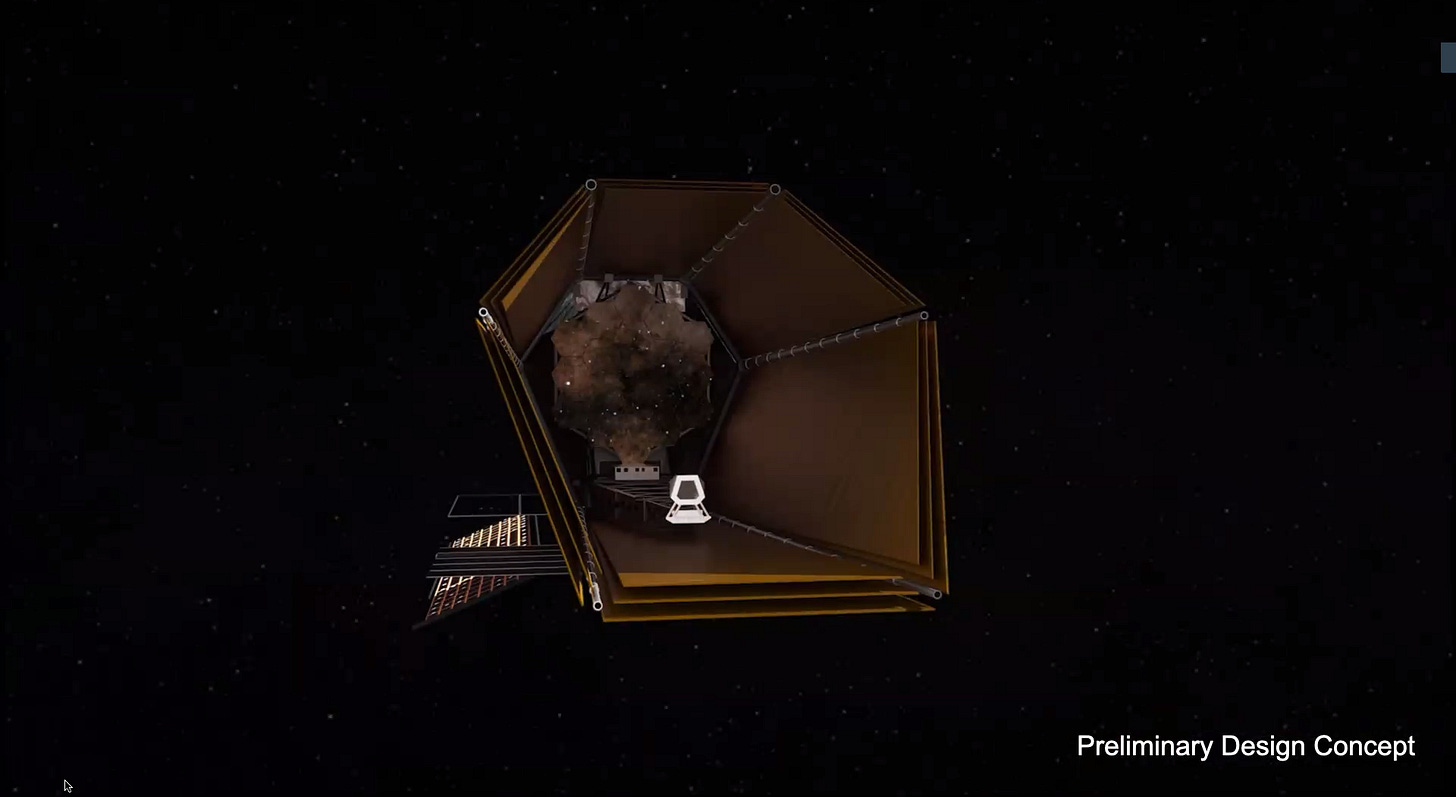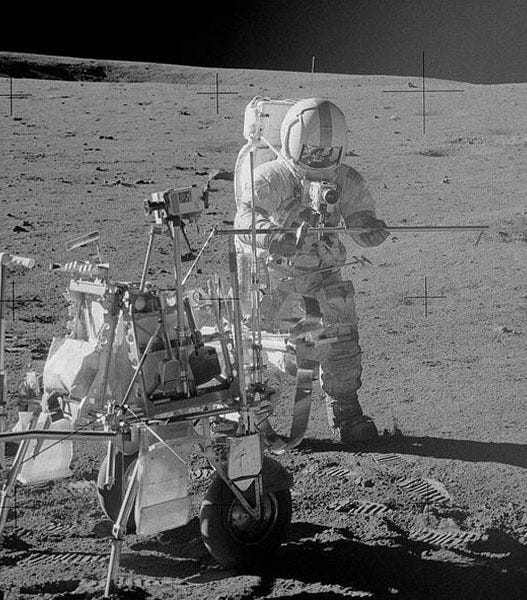TGT #25B - Finding Earth 2 - A Pair of Crescents - Feb. 6th Anniversary - Moon Activity for UK National Astronomy Week -
TGT 2/1/25: This Just In--Habitable World Observatory Plans, Checklist for Finding Earths; TCA--Chasing the Moon; Calendar--Crescents Venus and Moon; AEL--Holes in Two.
Cover Photo - Earth and Solar System from Afar
In This Issue:
Cover Photo — Earth and Solar System from Afar (HWO Simulation)
Welcome to Issue 25B!
This Just In —
* Looking for Earth-like Planets—Are We Actually Not Alone? , Part 2 (Cover Story)Sky Planning Calendar —
* Moon-Gazing - Catch Crescent Venus Next To Crescent Moon!
* Observing—Plan-et - Moon Covers Saturn and Mars But Not for Most of Us.
TCA — Sky Lessons: Chasing the Moon
Astronomy in Everyday Life — On February 6th….
Welcome to The Galactic Times Newsletter-Inbox Magazine #25B!
Greetings, Galactic Timers!
What do 6-irons and astronomy have to do with each other? Both involve holes in the ground. Specifically, we celebrate celestial and terrestrial versions in Astronomy in Everyday Life.
Speaking of the Moon (we spoke of that?), do your kids think the Cookie Monster eats the Moon? Give them proof as shown in the Sky Planning Calendar—locate the Moon and Venus together in the sky this week and see in binoculars or telescopes that both are crescent shape. A great photo-op and motivator for your own little cookie monsters.
In This Just In we complete a two-part look at exploring the universe for Earths. In this part the designs for the Habitable World Observatory are discussed with a kind of checklist of what to look for, and what can confuse us.
And in TCA—the Towards Cosmic Awareness column—an activity to do this week, with or without little monsters or students, from the United Kingdom’s Astronomy Week people, a worksheet called Chasing the Moon.
- - - -
In my other life as a writer of history, an article on Lafayette’s tour of Alabama—and what’s left from 200 years ago—has come out in Alabama Heritage Magazine. You can read about it here.
Enjoy!
- - - -
Do you want to get these issues right away in your mail inbox? Then subscribe. We don’t put the latest issue up on the Substack webpage until a week later.
* Not a Subscriber? Want to read this off the Web? Please hit the link..right… below:
Enjoy!
Publisher — Dr. Larry Krumenaker Email: newsletter@thegalactictimes.com
This Just In
Looking for Earth-like Planets—Are We Actually Not Alone? (Part 2)
The Habitable World Observatory
In our last issue, we looked at some research done looking for exoplanets around cooler-than-the-Sun-but-more-numerous M-dwarf stars. The research searched a 50-light-year bubble around the Sun for exoplanets around these reddish long-lived stars and drew some conclusions about the frequency of habitable worlds around them. In this issue we look at the Habitable World Observatory (HWO), not set to launch for at least another decade, which will look among F, G and K stars for not only habitable worlds, but inhabited worlds. These stars are a bit hotter (F) and cooler (K) than solar G type stars, more like us in other words. Giada Arney, interim project scientist at Goddard Space Flight Center, took astronomers on an interesting foray to inhabited worlds at last month’s American Astronomical Society meeting. The HWO is not just another space telescope searching for exoplanets, maybe better or father, but it is designed to search for signs of life on exoplanets. And she gave a checklist of sorts about what needs to be looked for, and what signs could be false positives that could trap scientists.
Among its design elements is a coronagraph, like those used to observe the Sun’s atmosphere outside of eclipses, only these are to block star light so we can see the extremely dim light reflected off of exoplanets around the star, and directly image the worlds themselves.
Unlike the star with its hot gasses, the atmosphere of the the exoworld will show adsorptions from the star light passing through the molecules of the planet’s air. Evidence in the spectrum observed for water would tell us right away if there was a chance of life existing there but that’s not conclusive. It depends on how much is solid, liquid or gaseous. Methane, too, is a clue—cows and other animals, including bipedal primates make it—but it does occur naturally on its own—look at the gas giants. Evidence for ozone indicates that molecule, one that often comes later in a planet’s evolution. In fact, methane was considerably more present in Earth’s past, as was carbon dioxide, but oxygen and ozone are much more recent, geologically speaking. Why? Because life caused the Oxygen, and the Ozone comes from within reactions with the new Oxygen supply.
Oxygen comes out of photosynthesis of plants, and that takes time. It wasn’t until about 2.5 billion years ago that the Earth’s atmosphere began a change-over. HWO is being designed to look for all Earth’s, not just like today’s but also like the early eras of Earth’s.
What the F?
But how many Earth’s are there and how many—what fraction—have life? If that fraction f is only 10%, and if within the nearby stars there should be 25 possible worlds, then only one habitable world should be found. Conversely, Arney says if life is not detected on those 25 worlds, then the f would be no more than 10% and possibly much less.
As Arney put it, HWO will tell us if we are not alone—or how alone we really are.
Recent geological and biochemical research have found the effects of microscopic life in ancient chert rocks. But chert is a rock that comes out of high volcanic activity. So looking just for ‘relatively’ geologically ‘calm’ worlds may be the wrong signal to look for. Volcanically active worlds need also be examined. Environmental contexts, including temperatures and water amounts, are needed. These are partially determined by planetary orbital motions and distances. Spectroscopy can look for other biosignatures, such as finding methane in excess of non-biological sources of methane, along with Oxygen is a key biosignature.
HWO, once it gets into orbit, may be THE instrument that tells us if we are unique, a standard planetary system and life form and planet, or one of many.
Sky Planning Calendar
Moon-Gazing
Moon passages by a star, planet or deep sky object are a good way to find a planet or other object if you’ve never located it before.
February 1 The Moon is the active object this 24 hours. Early on in the predawn near midnight hours Saturn will be found about 1.1 degrees—or less—South of the Moon. If you travel to very far NW Alaska in the USA, or much of northern Europe, you can see Saturn get occulted (covered up) by the Moon. After you have slept off the experience during the day hours, find Saturn replaced by Venus, two degrees North of the Moon during evening hours. Both objects will be comparably-shaped crescents.

On top of THAT, the Moon is at its largest size for the month, passing through Perigee, its nearest point to Earth in its orbit, just before midnight.
February 5 First Quarter Moon.
February 6 A doubly-active Moon, again. In the pre-dawn near midnight the Moon passes North of a star cluster, the Pleiades, by a half degree. For some, in the predawn, the Moon will pass over some of the cluster’s stars. This evening, the Moon passes a wide 5-degrees from bright Jupiter.
February 9 Mars is nominally 0.8-degrees South of the Moon but in New England, part of New York state, and much of northern and northeastern Canada (and N. Europe and much of Asia), observers get what the whole USA saw last month, the Moon covering up Mars. The bad news…you’ll have to use a telescope because it happens during the afternoon in North America.
February 10 The Moon passes just North of another star cluster, the Praesepe, the Beehive cluster.
February 12 Full Moon. In this instance, the bright star Regulus is just missed to the North by this evening’s Full Moon. The next Full Moon, in 30 days, will be totally eclipsed for North America at least, but at an inconvenient after-midnight-until-dawn show. Details in a future TGT issue.
Observing---Plan-et
==Highlight: Most Brilliant Time for Venus==
==The Last Time to See Four Bright Planets in the Winter Evening Sky==
Mercury is a no-show for this fortnight. It is orbiting behind the Sun, in conjunction with it on the 9th.
Venus reached its maximum distance late January, sets at its latest time in the night on the 4th, and reaches maximum brightness on Valentines Day, the 14th. It is a thinning crescent, large enough (and growing) in size to be seen in binoculars. Compare the crescent shapes of the planet and the Moon when Luna passes it on the 1st, as noted above.
It will first slowly, then rapidly, head into the twilight after this, to disappear from view in March.
Mars fades a bit as the Earth increases its distance from the Red Planet, and on the 14th it sets as morning twilight begins, ending its up-all-night life for this year. It is covered on the 9th by the Moon for some.
Jupiter rules the evening sky, sedately shining until about 2 AM when it sets. It barely moves, reaching a stationary point between retrograding, moving westward like Mars, to going prograde—eastward—on the 4th.
Saturn starts the month getting passed closely by the Moon on the 1st, covered up by it in very far northern lands, then setting just over an hour after evening twilight ends. But by midmonth, that gap is just a few minutes. After that, Saturn will rapidly sink into the twilight glow and be gone from the evening sky until late summer.
TCA-Sky Lessons: Chase the Moon
National Astronomy Week in the United Kingdom begins February 1st. For nine days the Brits will have nationwide events, activities you can do at home, and more. Here’s the link to resources such as social media graphics, videos for streaming, and more:
<https://drive.google.com/drive/folders/1pkY0NL7a3yYOfMqFgzc3Gb6NZLGWmPZ-?usp=drive_link>,
The neatest resource TGT found was an activity called Chase the Moon. You chart and follow the Moon across the sky for nine days, and learn the constellations, the currently planetary sky, and more.
Here’s a copy of their template. On it, you plot the shape below and the position on the chart and learn the sky.
Note: National Astronomy Week/Day varies with country, locations within the country (like in parks), and by year. In the USA, this year there are two, one beginning in May, the other in September.
Astronomy in Everyday Life
On February 6th….
Fifty-four years ago, in 1971, a golf tournament of one person and far more than 18 holes took place.
The winner, by default, was America’s first astronaut, Alan Shepherd, on his only non-suborbital space flight, a flight to the Moon’s surface a decade after that first flight. The two-ball game took place during one of his excursions from his Apollo lunar lander.
Shepherd, a known avid golfer, built a jury-rigged golf club from a 6-iron head and attached it to a long sample recovery tool handle, and he took it into space with his Apollo 14 colleagues, Stuart Roosa and Edgar Mitchell. No caddy but a hand-towed cart for their walks and experiments acted as his golf club bag. Because the space suits were so bulky he could only swing one-handed and even then he waited until the end of the mission (sort of like a modern golfer waiting for the end of the week) to drop two balls to the lunar surface. With all that, it STILL took four swings to launch the balls out of his large sand trap.
It has been a bit of a mystery what happened to the balls. Like many golfers Shepherd exaggerated the distance the balls traveled in the 1/6th-of-Earth gravity. Astronaut Mitchell found the first ball, a mere 24 yards, definitely under par with three shots to do that. It took a science imaging specialist, Andy Saunders, 50 years later, to find the other ball on digitally enhanced scans of the original film taken during Apollo 14. Instead of going miles (or even a standard hole distance in triple digit yards) it went …. 40 yards.
What got me to research this—I’ve got not the slightest interest in golf—was stumbling across the enterprise illustrated below in Auburn, AL.
I hadn’t the nerve to go in and see if there were any Alan Shepherd photos on the walls.
It turns out that the “Moon” is due to the owners’ real last name. Once a golfer on the Auburn University golf team, Anne Moon had married fellow fan Dan Moon and they opened up three Moon Golf stores.
There actually is a Moon Golf Course, not associated with the store or its owners. It is looked in….Moon Township, PA. I wonder if there are any Alan Shepherd photos on that course’s clubhouse wall…..
A Patreon account has been set up for The Galactic Times. Right now, the one tier is simply a $2.50 monthly support for your kindness, since The Galactic Times is an otherwise free newsletter now. But we can use the help.
To support TGT, please head over to our Patreon for The Galactic Times site.‘










